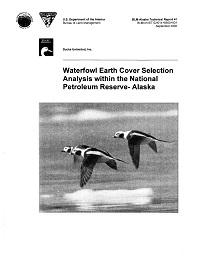Waterfowl Earth Cover Selection Analysis within the National Petroleum Reserve-Alaska

The intent of this study was to investigate the correlation between the earth cover classes mapped by Alaska Bureau of Land Management (BLM) and Ducks Unlimited, Inc., (DU) within the National Petroleum Reserve-Alaska (NPR-A) with the locations of seven waterfowl species collected by the U.S. Fish and Wildlife Service (FWS). The FWS has been conducting aerial surveys of spectacled eider populations over the Arctic Coastal Plain since 1992, and has also collected valuable information on 35 other avian species. The earth cover map was created by DU and BLM using Landsat Thematic Mapper (TM) and System Pour I 'Observation de la Terre Multispectral (SPOT XS) satellite imagery acquired between 1992 and 1994. Both the earth cover classification and the breeding bird survey methodology were developed to collect data over a large area. The project area included the entire extent of the NPR-A to the east and west, but extended south only to the limit of the waterfowl surveys conducted by FWS, which roughly corresponds to the Arctic Coastal Plain physiographic province.
The seven species of waterfowl included in this study are spectacled eider (Somateriafischeri), Steller's eider (Polysticta stelleri), king eider (Somateria spectabilis), oldsq___ (Clangula hyemalis), Canada goose (Branta canadensis), brant (Branta bernicla), and white-fronted goose (Anser albifrons). Two of the species, the spectacled eider and the Steller's eider, have been declining in numbers and are listed as Threatened under the Endangered Species Act of 1973 (as amended). In the first phase of the analysis, earth cover type selection indices are described for all seven species of waterfowl. The selection index analysis compares the proportions of available earth cover types to the proportions selected by the observed waterfowl. Upon finding a correlation between the distribution of observed spectacled eider locations and selected earth cover types, the second phase of the analysis went on to model resource selection. A logistic regression function was used to produce relative probability of occurrence surfaces for the spectacled eider.
The results of the resource selection analyses lead us to conclude that the NPR-A earth cover data can be used in conjunction with waterfowl point data to study the distribution of waterfowl across the Arctic Coastal Plain. This conclusion is supported by several factors; 1) there are definite, non-random differences between the earth cover types selected by different species, 2) the logistic regression model test results indicate the model does have predictive ability, and; 3) the earth cover types selected by the waterfowl species studied largely coincided with the findings of previous and more intensive studies.
The possibility of expanded petroleum and natural gas resource exploration and development is currently being analyzed for a portion of the NPR-A. Baseline earth cover and wildlife data provide a basis for planning the multiple-use management of this vast and remote area in the event that development in the Arctic Coastal Plain expands. The methods outlined in this paper provide a relatively fast and efficient way to analyze the baseline data that have been gathered to date in a macro-analysis of this arctic landscape.
